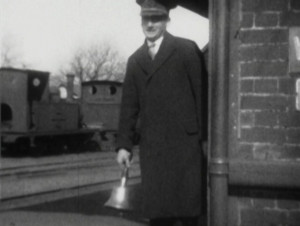
"A locally made film of the Southwold to Halesworth narrow-gauge railway." (EAFA Database)
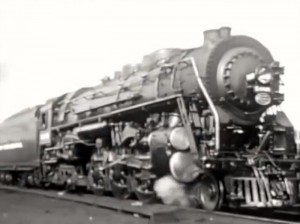
"The Steam Locomotive, second release in the Know Your Railroad series, sponsored and produced by the Motion Picture Bureau of the New York Central System, is a worthy successor in this intelligent line of educational films. In it, Frederick G. Beach, supervisor of the bureau, has set forth in clean cut cinematography the design, construction, operation and maintenance of the famous Hudson type locomotive. An animated model of a steam cylinder explains the otherwise hidden functions of this key piece of machinery, while a soundly conceived narrative points up the film's visual teaching throughout. A stirring sequence showing these great coal eating giants at their daily tasks brings the picture to a dramatic close." Movie Makers, Dec. 1944, 495.
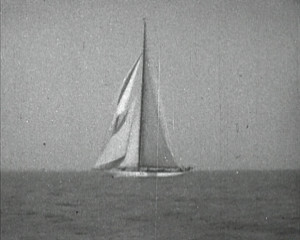
"One of a series of films recording the travels of the schooner Elver, her owner V.B. Harrison, crew and guests. Scenes are shot from the Elver including adjustment of sails, sea, waves, buoys, coastline and passing boats, sometimes close enough to see crew in detail." (EAFA Database)
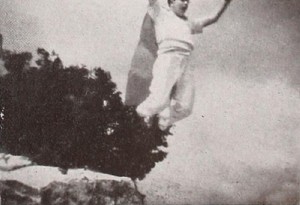
"Donald H. Kelly has cast a comic strip character in Superman Goes West, integrating travel sequences and comedy with great success. While the magnificent cinematographic record of a Western trip is the most engaging factor of the film, the entertainment value of the Superman motif cannot be minimized. The fictional hero is shown to be the consuming interest of a small boy passenger on the trip. The lad proceeds to read Superman comics under varying conditions, despite a changing background of allegedly awe inspiring scenery. One dream sequence with a Superman flavor is a triumph of trick cinematography." Movie Makers, Dec. 1943, 478.
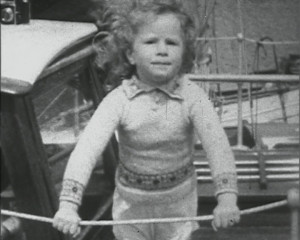
"This film shows the excavation of a 7th-century ship at Sutton Hoo led by Charles Phillips, a fellow at Cambridge." (EAFA Database)
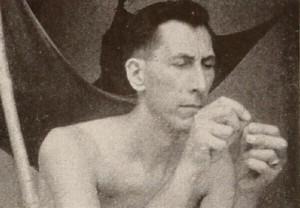
"It is generally accepted by the less moronic elements that Hollywood's version of life in the army not only missed the point but overlooked it completely. Reginald McMahon, a hardy private first class during the war, has compensated greatly for Hollywood's sins in his Sweating It Out, a clever film recording the period between V-J day and his return from overseas. Mr. McMahon was with the 24th Combat Mapping Squadron, stationed at Gushkara, India. He was in a position to show what a hot, boring climate does to military stiffness and the blithe American temperament; and he has done so. Barracks life becomes very real in his hands, with its essential lack of glamour, its endless small detail and its everlasting poker games. The negative aspects of army life at an outpost — K.P. and guard duty — come in for their proper share of bitter comment. Mr. McMahon is to be thanked for recording the trivia that make up army life in a way that makes one almost nostalgic for them." Movie Makers, Dec. 1946, 488-489.
"Filmmaker George Jesse Turner gets alarmingly close to the action as he records the thrills of motor racing on Southport's golden sands, with Tailwagger 1 and other cars hurtling around him. The town became famous not only for racing, as Southport sands also saw land speed record attempts, with the likes of Sir Malcolm Campbell and Sir Henry Segrave drawing huge crowds of spectators." (BFI Player)
"Two popular subjects make up this short amateur film - cricket and aircraft. After scenes of bi-planes, we visit the Ashes 4th Test at Old Trafford in July 1930. After the toss between captains Bill Woodfull and Percy Chapman, the crowd applauds cricketers onto and off the field. This test match fell foul of the Lancashire weather and had to be left drawn, rain stopping all play on the last day." (BFI Player)
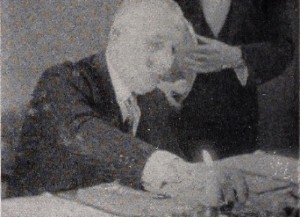
"When a preaching film turns out to be entertaining, the advice it offers is more likely to be remembered and heeded. In Time To Consider, a film that advocates bicycle safety, the Fourfold Film Society dramatized its subject with delightful imagination and refreshing use of the black and white medium. A pompous gentleman, after being splashed by a bus on the way to his club, vents his ire by "writing to the Times." A messenger takes the envelope, which is addressed simply Time," and starts off on his bicycle, only to be run over in traffic. The film then switches to fantasy, as the messenger, dressed now in white livery, delivers the letter to Father Time's heavenly establishment. Father Time, peering at a celestial television screen, observes the various traffic mistakes that mortals make and, between sequences showing unwise behavior, he dictates the rules of proper procedure. The production's few scenes of uneven exposure are more than made up for by its rich imagination, excellent cutting and refreshing camera treatment." Movie Makers, Dec. 1948, 495-496.
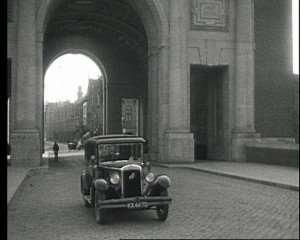
(Reel 1) - "First in a series of eight film reels recording Eustace and Eunice Alliott’s trip to and from the Oberammergau Passion Play in 1930, by way of a motor tour through Belgium, Luxembourg and the Rhine, before travelling further south to northern Italy, Liechtenstein and Switzerland, returning to London via Germany and Belgium. The first reel in this series records details of Alliotts' journey through Belgium and Luxembourg. Scenes include: visits to war memorials and observations of activities of local inhabitants. The visits to war memorials notably emphasise connections or interests that Eustace Alliott might have had or felt towards the sacrifices made by engineers or men from Lancashire. Scenes include: the Alliotts' car being loaded on to a ferry at Dover; shots of Ypres, notably the ruins of the Cloth Hall, the Menin Gate and market scenes near the Cloth Hall; visits to war memorials near Ypres, including Hill 60, Zillebeke, the Tyne Cot cemetery and the church at Passchendaele; the journey through Belgium including visits to Courtrai, Tournai, Mons and Namur, where the Alliotts' record celebrations of the centenary of Belgian independence; the journey by the Rivers Sambre and Meuse including their visits to Old Dinant and Chateau de Walzin; and time spent in in the gardens, streets and alleys of Luxembourg. Shots at Belgian war memorials include: a visit to the Hill 60 war memorial, where Eunice, along with members of the Farnham girl guides, inspect a concrete bunker; walk through and inspect a trench at Zillebeke, including a shot of the trench and abandoned munitions (trench now filled in, see http://www.ww1battlefields.co.uk/flanders/hill60.html); a visit to the Tyne Cot cemetery where Eunice inspects the inscription at the base of the Great Cross, including a clear shot of the inscription that has since been corrected (it reads captured by 2nd Australian Division [now corrected to 3rd Australian Division] 24 October 1917); at Tyne Cot Eunice walks past and looks at the Tyne Cot Memorial to the Missing; there is a shot of a headstone of one of the unidentified servicemen of the Royal Engineers; by the side of a road Eunice retrieves a discarded helmet; there is a shot of the Passchendaele church window memorial to British dead from “Duchy of Lancaster”. Shots at Namur for the centenary celebration of Belgian independence include: a procession of soldiers and dignitaries; Eunice with members of a Pierrot troupe, including shots of the troupe in a street procession." (EAFA Database)
(Reel 2) - "Second in a series of film reels recording Eustace and Eunice Alliott’s trip to and from the Oberammergau Passion Play in 1930, by way of a motor tour through Belgium, Luxembourg and the Rhine, before travelling further south to northern Italy, Liechtenstein and Switzerland, returning to London via Germany and Belgium. The second reel in this series records details of Alliotts' journey from Trier along the Moselle and Rhine river valleys [through the demilitarised area of Germany established by the Treaty of Versailles] to Bensheim. Scenes include: tourist attractions and observations of activities of local inhabitants. Shots of tourist attractions include: historic monuments in Trier; a visit to a Traben vineyard; castles along the Moselle and Rhine valleys; the Wilhelm I monument in Koblenz. Shots of local activities include: the market places in Trier and Bernkastel; agricultural labourers in the Moselle valley transporting hay; women and children bleaching linen by the side of the river in Bernkastel; agricultural labourers using ferries near Traben and fruit being picked along the road; river traffic on the Rhine at Koblenz with particular emphasis on the operation of a bridge consisting of boats. The reel concludes with a record of the Corpus Christi street celebrations in Bensheim. Many of the scenes include Eunice Alliott, who walks or drives into shot, or interacts with local inhabitants, or perhaps has persuaded individuals to pose for the camera, such as children at the Roman Basilica in Trier and a two man band in Stoltzenfels." (EAFA Database)
(Reel 3) - "Third in a series of film reels recording Eustace and Eunice Alliott’s trip to and from the Oberammergau Passion Play in 1930, by way of a motor tour through Belgium, Luxembourg and the Rhine, before travelling further south to northern Italy, Liechtenstein and Switzerland, returning to London via Germany and Belgium. The third reel in this series records details of Alliotts' journey from Heidelburg through the Neckar valley and Bavaria to Oberammergau, including shots of Oberammergau and the surrounding mountains. Scenes include: visits to historic monuments and tourist attractions as well as observations of the activities of local inhabitants. Notably, the film reel includes a day out with unidentified friends in Heidelberg and perhaps inadvertently a shot of the presence and activities of the national socialist party in and near Heidelberg.
Shots of tourist attractions and historic monuments include Heidelberg Cathedral and square, including a building with the sign ‘National Sozialistische Deutsche Arbeitespartei’; Heidelberg castle; river cruise boats at Neckargemünd; Ulm cathedral; and as the Alliotts' approach Oberammergau shots of the landscape. Shots of the activities of local inhabitants include: children playing by the river at Neckargemünd; a youth rambling group in the Neckar Valley; street scenes in Neckarsulm and a fair outside Ulm cathedral; street scenes in Oberammergau, highlighting the numbers of tourists in the village for the passion play. Many of the scenes include Eunice Alliott, who walks or drives into/ out of shot, such as watching a steam tug on the Neckar or admiring the view at Schongau or leaving Neckarsulm. Both Eustace and Eunice Alliott appear in shot during the picnic at Heidelberg. Notably Eustace Alliott appears in shot at Heidelberg, Schongau and possibly once driving the Austin Sixteen. Eustace Alliott also features in the section following the intertitle ‘Part II – Oberammergau, June 1930’, appearing mountain walking near the Kofel mountain and mountains overlooking Oberammergau." (EAFA Database)
(Reel 4) - "Fourth of a series of film reels recording Eustace and Eunice Alliott’s trip to and from the Oberammergau Passion Play in 1930, by way of a motor tour through Belgium, Luxembourg and the Rhine, before travelling further south to northern Italy, Liechtenstein and Switzerland, returning to London via Germany and Belgium. The fourth reel in this series records details of Alliotts' stay in Oberammergau, focusing on the 1930 Passion Play and their interaction with key members of the cast. Shots include: women washing and drying laundry away from the main streets; the Alliotts' accommodation and host; crowds outside the theatre; official photographs of the production; audience and actors leaving auditorium; meetings with key actors in the production, notably Anton Lang (Prologue) with Eunice; Alois Lang (Christ), Anni Rutz (Mary) with Eunice; Johanna Preisinger (Magdelene); unidentified actor (John); Guido Mayr (Judas) with Eunice." (EAFA Database)
(Reel 5) - "Fifth of a series of film reels recording Eustace and Eunice Alliott’s trip to and from the Oberammergau Passion Play in 1930, by way of a motor tour through Belgium, Luxembourg and the Rhine, before travelling further south to northern Italy, Liechtenstein and Switzerland, returning to London via Germany and Belgium. The fifth reel in this series records details of Alliotts' journey through the Tyrol in Austria, and Italy. The records details of the Alpine scenery and observations of the activities of the inhabitants in the Tyrol, with a particular fascination with agricultural labour and the work of women. Shots include: the Alliotts leaving Oberammergau; flags in Mittenwald celebrating the ‘freeing’ of the Rhine; alpine landscapes in the Tyrol at Seefeld, Reith im Alpbachtal, Lanser Kopfe, Hafelekar, Serles, Vipeteno, Lake Misurina, Croci Pass and Monte Piana; agricultural and rural labour in the Tyrol; women washing laundry in a village in the Stubaithal; road construction near Misurina; the Austin Sixteen off the road ascending Monte Piana, assistance provided by Austrian motorists." (EAFA Database)
(Reel 6) - "Sixth in a series of film reels recording Eustace and Eunice Alliott’s trip to and from the Oberammergau Passion Play in 1930, by way of a motor tour through Belgium, Luxembourg and the Rhine, before travelling further south to northern Italy, Liechtenstein and Switzerland, returning to London via Germany and Belgium. The sixth reel in this series records details of Alliotts' journey through northern Italy from the Dolomites to Lake Como. Scenes include: landscape shots of mountain peaks (including the Dolomites, and mountain peaks at the Stelvio Pass); observations of the local population and activities (including children, villagers, and soldiers who pose for the camera in the Dolomites; village street scenes in the Karerpass [Costalunga Pass]; agricultural labourers engaged in harvesting; fishing on Lake Como; and the progress of road improvements around Lake Como); a stop at a roadside war memorial in the Karerpass and in the Stelvio Pass Eunice examines reminders of war found by the roadside; visits to local sightseeing attractions on Lake Como, as well as boat trip on the lake. Notably, as in other reels, the scenes in this film record work done by women as part of the agricultural workforce and in domestic duties, with shots of women engaged in harvest work and washing laundry." (EAFA Database)
(Reel 7) - "Seventh in a series of film reels recording Eustace and Eunice Alliott’s trip to and from the Oberammergau Passion Play in 1930, by way of a motor tour through Belgium, Luxembourg and the Rhine, before travelling further south to northern Italy, Liechtenstein and Switzerland, returning to London via Germany and Belgium. The seventh reel in this series records details of Alliotts' journey from northern Italy to Switzerland, passing through Liechtenstein. Scenes include: sightseeing in Milan; mountain walks at the Morteratsch glacier and in the Bernina Pass in Switzerland; a stop at a fortified border post in Liechtenstein; sightseeing at Vaduz castle; a meeting with a female peddler; a street scene in Altdorf; views of Lake Lucerne; and a visit to the Rhone glacier. Shots of local sightseeing attractions in Milan include Galleria Vittorio Emanuele and Milan Cathedral; street scenes outside the cathedral; Eunice tours the roof of Milan Cathedral; pan shot from roof over Milan; Eunice walks in the gardens at Santa Maria delle Grazie. Shots in the Alps include Eustace observing the view at the Morteratsch glacier; mountain scenery at the Bernina Pass; views from and in the castle at Vaduz; a peddler in Clausen Pass; female swineherds; the fountain at Altdorf, the river at Andermatt; the Rhone glacier with shots of Eunice walking on the glacier and with other tourists at an ice cavern, as well as of the valley below glacier and the glacier from valley." (EAFA Database)
(Reel 8) - "Final reel (in a series of eight) recording Eustace and Eunice Alliott’s trip to and from the Oberammergau Passion Play in 1930, by way of a motor tour through Belgium, Luxembourg and the Rhine, before travelling further south to northern Italy, Liechtenstein and Switzerland, returning to London via Germany and Belgium. The final reel in this series records details of the Alliotts' return journey from Switzerland through Germany and Belgium to London. Scenes include: unusual sights encountered on the road, records of visits to areas of scenic beauty and sightseeing tours in towns and cities, as well as observations of the activities of local inhabitants. Shots include: an encounter with cattle on the road in Switzerland; waterfalls at the Handegg and Rhine Falls; lumber being moved near Titisee; street scenes at Freiburg, including shots of the market near the cathedral and shots of people wearing traditional clothing; sights in Baden-Baden, Worms, Frankfurt, Louvain and Ghent, including the Luther Memorial, market place in Frankfurt and Van Eyck Monument; observations of activities in Ghent, including a boat being unloaded. The film concludes with a shot of the fountains in Trafalgar Square. Notably, on their return visit to Koblenz the Alliotts' obtain shots of a rehearsal for a visit by Hindenburg, on the Deutches Eck, including a long shot of a small group of national socialists amongst the crowd who perform a salute. Shots also reflect the Alliotts' interest in mechanical engineering (the ferry across the Rhine near Karlsruhe) and dogs (Ghent and Bruges)." (EAFA Database)
Total Pages: 12